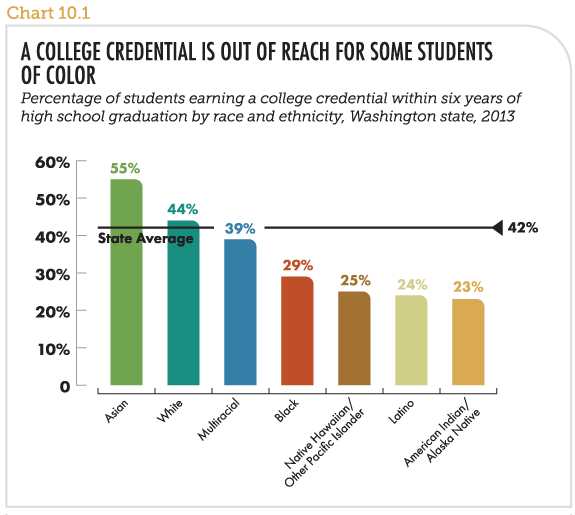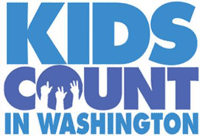Structural racism—the way that policies, practices, and programs combine and interact to sustain poorer outcomes among communities of color—undermines progress for children.
A high quality education system—one that empowers children to excel in school from preschool through higher education—supports students in reaching their full potential, and is essential for the future competitiveness and economic vitality of Washington state.
Jump down to indicator:
- Percentage of Children Ready for Kindergarten
- Percentage of Third Grade Students Meeting Reading Standards
- Percentage of Students Graduating from High School on Time
- Percentage of Students Earning a Credential Within Six Years of Graduating High School
Percentage of Children Ready for Kindergarten
Why is this indicator important?
A child entering kindergarten should exhibit age-appropriate cognitive, social and emotional skills. Quality early learning in culturally and linguistically responsive environments, characterized by nurturing relationships and rich opportunities for play and exploration, lays the foundation for learning in elementary school. Compared to their peers, children who enter kindergarten without a solid foundation in early learning may have a harder time meeting important educational, social, or even physical milestones throughout school. ((United Way Worldwide (2012) ))
How is Washington state doing?
Since the start of data collection in 2011, just four in ten children entering kindergarten are prepared in all six areas of readiness: social, emotional, physical, cognitive, literacy, and math (Chart 7.1). Stark differences along lines of race and ethnicity are apparent at this time (Chart 7.2). Rates of kindergarten readiness also vary considerably across the state—with just 11 percent of young children in Whitman County prepared in all six areas of readiness, and 88 percent in Columbia County (Chart 7.3).
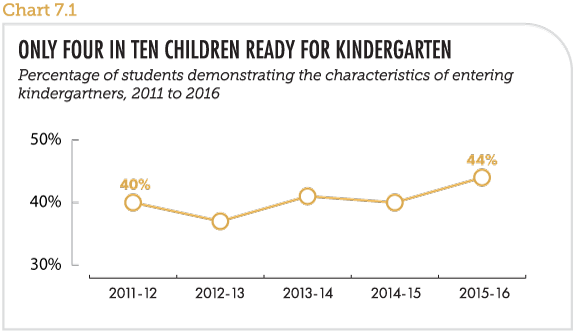
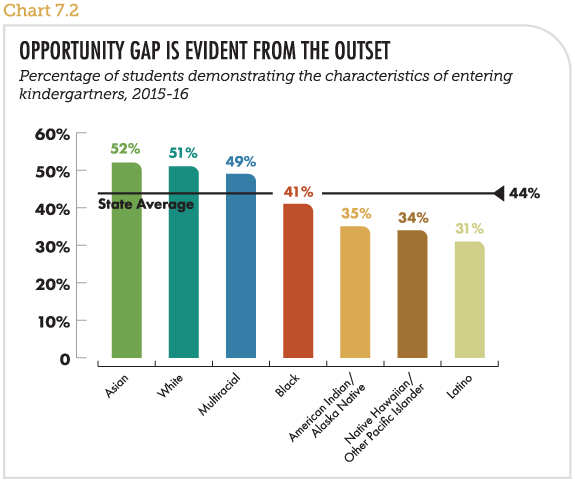

Percentage of Third Grade Students Meeting Reading Standards
Why is this indicator important?
Being able to read proficiently by the end of third grade is a critical benchmark for students. Up until that time, children are learning to read; after that time, they are reading to learn. Reading proficiently by third grade is a predictor of future achievement, as well as a predictor of the likelihood of graduating on time and attending college. ((Annie E. Casey Foundation (2010) .))
How is Washington state doing?
The test to assess third grade reading proficiency has changed over the years, making it difficult to evaluate trends. Former tests—the Washington Assessment of Student Learning (WASL) and the Measuring Student Progress (MSP)—showed that seven out of ten third grade students were meeting reading standards by the end of third grade, although there had not been much improvement from past years (Chart 8.1). The new test—Smarter Balanced Assessment (SBA)—measures English proficiency and language arts knowledge, and has a much lower rate of children passing: 52 percent. Children of color have much lower rates of third grade reading proficiency than the state average (Chart 8.2), and rates also vary considerably by county, ranging from 21 percent in Skamania County to 72 percent in Garfield County (Chart 8.3).
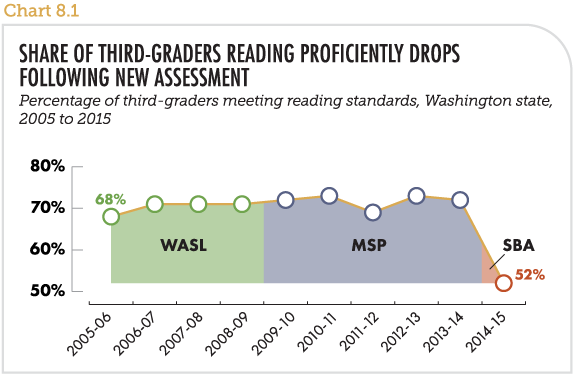
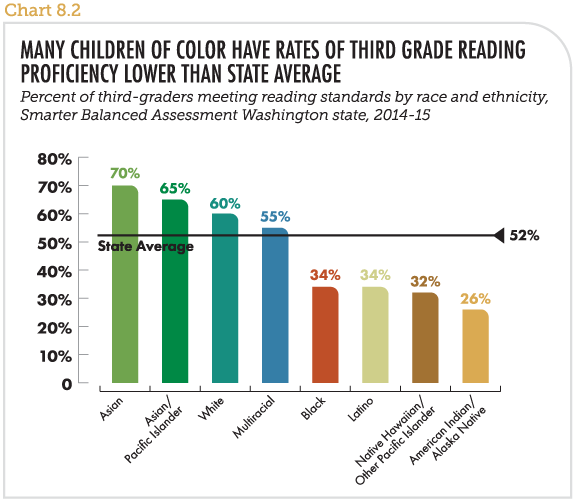
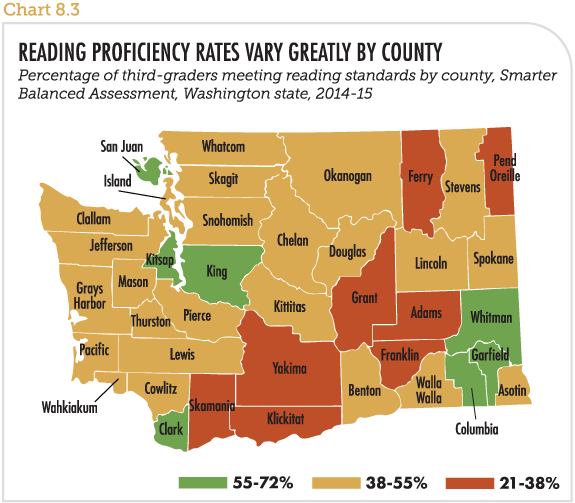
Percentage of Students Graduating from High School on Time
Why is this indicator important?
A high school diploma is the minimum amount of schooling that most students need to enter college or get a job. Graduating on time from high school—within four years—is an important predictor of college enrollment, and students who do so are less likely to drop out of college before receiving a diploma. ((Tyler, J. and M. Lofstrom (2009) . Future of Children; v19 (1).))
How is Washington state doing?
On-time graduation rates for high school students—receiving a diploma within four years—have remained steady for some time, hovering around 78 percent for the last five years. There are stark differences among students of color, however. While Asian, White, and multiracial students have graduation rates at or above the state average, rates for Latino (70 percent), Black (69 percent), Pacific Islander (67 percent), and American Indian/Alaska Native (56 percent) students fall below the state average. Aggregate data about Asian youth hides serious disparities in educational outcomes for students of Cambodian, Laotian and Hmong descent. There is also significant variation across counties, with the lowest rate in Clallam County (54 percent) and the highest rate in Columbia County (95 percent).
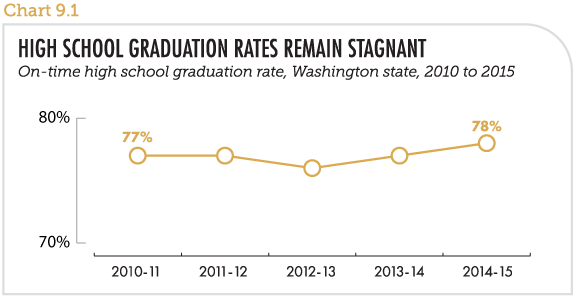
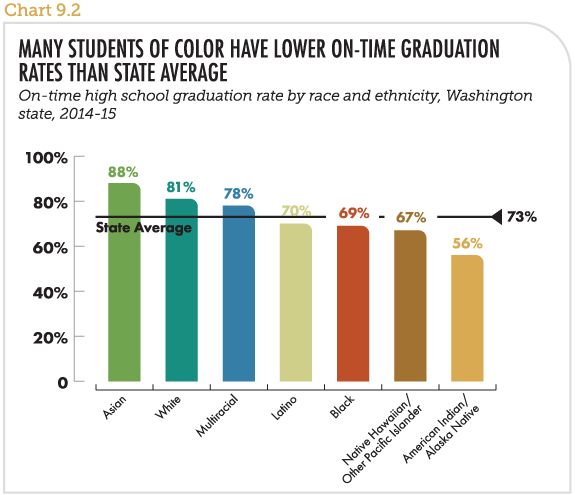
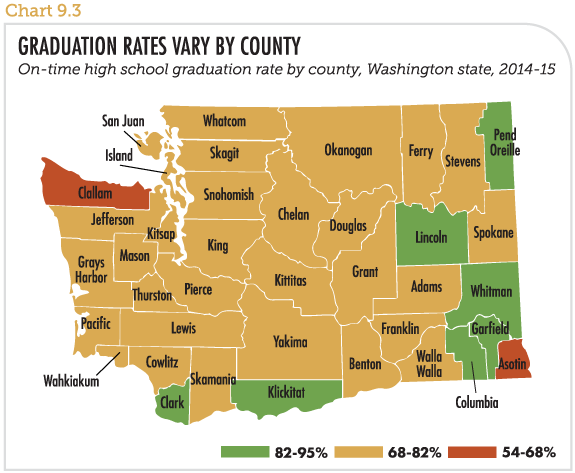
Percentage of Students Earning a Credential Within Six Years of Graduating High School
Why is this indicator important?
Earning a college credential (i.e., a college degree or a vocational certificate) is essential to compete for living-wage jobs. When a high school graduate goes on to earn a certificate credential in their early 20s, it sets them up well for a career that will allow them to meet basic needs and eventually get ahead. ((Washington State Board of Community & Technical Colleges (2005) .))
How is Washington state doing?
A recent study of high school students that graduated in 2006 showed that 42 percent went on to earn a credential within six years. Graduates of color had rates much lower than the state average, with approximately one in four Black, Native Hawaiian/Pacific Islander, Latino, and American Indian/Alaska Native graduates earning a credential within six years (Chart 10.1).
